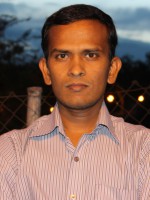resumo
Herein, diopside based glass-ceramics (GCs) were produced by sintering of glass powder compacts at 850 degrees C for 300 h. A special attention was paid on understanding the influence of structural transformations upon substituting strontium for calcium on the Eu3+ emission behavior. X-ray diffraction and Raman spectra showed the formation of diopside (CaMgSi2O6) in Sr-free glasses. Introduction of Sr led to the appearance of Sr-akermanite (Sr2MgSi2O2), whose formation increased continuously with increasing Sr/Ca ratio. The photoluminescence spectra exhibited intense D-5(0) -> (7)Ej transitions of Eu3+ ions. The intensity parameters (Omega(2) and Omega(4)) and the Eu-O ligand behavior were determined using the Judd-Ofelt (JO) theory from the emission spectra as a function of various Sr concentrations. The as obtained JO intensity parameters Omega(2) (5.31-5.21 pm(2)) and Omega(4) (4.89-5.84 pm(2)) indicated the ligand behavior of the Eu-O bonds and a high asymmetrical and covalent environment around Eu3+ ions in the present host matrix. In comparison with other Eu3+-doped GCs, diopside based GCs containing high fraction of SrO exhibited adequate photoluminescence for optical lighting and display devices. (C) 2017 Elsevier B.V. All rights reserved.
palavras-chave
RARE-EARTH IONS; LUMINESCENCE PROPERTIES; QUANTUM EFFICIENCY; ENERGY-TRANSFER; PHOSPHORS; RED; SPECTRA; DY3+; SUBSTITUTION; FLUORESCENCE
categoria
Chemistry; Materials Science; Metallurgy & Metallurgical Engineering
autores
Allu, AR; Das, S; Som, S; Maraka, HVR; Balaji, S; Santos, LF; Manek-Honninger, I; Jubera, V; Ferreira, JMF
nossos autores
agradecimentos
The authors thank the CNRS, the Aquitaine region and the pole de competitivite Routes de lasers (R). This study was carried out with financial support from the French State, managed by the French National Research Agency in the frame of "the Investments for the future" Program IdEx Bordeaux - LAPHIA (ANR-10-IDEX-03-02), EXOLAS project. Part of work was partially funded by FEDER funds through the Operational Programme Competitiveness Factors (COMPETE 2020) and the Portuguese Foundation for Science and Technology (FCT) (SFRH/BD/89915/2012) and CICECO-Aveiro Institute of Materials (UID/CTM/50011/2013). A. R. Allu and S. Balaji. would like to thank Dr. K. Muraleedharan, Director, CSIR-CGCRI and Dr. Ranjan Sen, Head, Glass Division for their support and encouragement.



